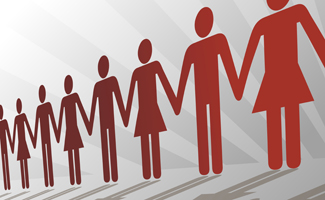-
Email
Linkedin
Facebook
Twitter
Copy Link

Loading...
Suppose you're a male employee who has just been invited to join a newly branded “Gender Network” in your company. This used to be the Women's Network, but they are now keen for men to join them to make faster progress on women's advancement. So they've changed the name to entice men in.
How do you react? Maybe you're a strong supporter of gender equality and have attended events run by the Women's Network where you were in a small minority. You believe in the cause but wonder if discussing strategies to address the biases of your fellow men is how you want to spend all your free evenings.
Or perhaps you weren't even aware of the Women's Network and think that women in your company are doing very well, thank you. What has the network got to do with you, unless it's to put you through gender re-education? You've got your own battles to fight and won't be signing up.
 To persuade people to embrace change, it's essential to demonstrate what's in it for them. Employee networks can be a powerful way to influence positive changes in corporate culture – or they can be ineffectual. A lot depends on how they are positioned.
To persuade people to embrace change, it's essential to demonstrate what's in it for them. Employee networks can be a powerful way to influence positive changes in corporate culture – or they can be ineffectual. A lot depends on how they are positioned.
Connecting through employee networks can help individuals advance their careers and companies improve their performance. To provide these benefits, however, networks must have a clear strategy, funding, senior sponsorship … and an attractive proposition for all potential members.
Last year, I wrote about research by consultants Veronika Hucke and Lisa Kepinski showing that many women's networks set out with high ambitions but produce poor outcomes. Hucke has built on that with a new report into the trend for companies to turn their women's networks into gender networks open to both sexes.
She finds that, despite good intentions, these newly framed networks struggle to attract men. Only 11% of survey respondents (these were network leaders, sponsors, and HR and D&I professionals) said they had enough men. The full report, Unconsciously Biased: Employee Networks 4.0, is available on her website: www.di-strategy.com/research-and-dialogue.html.
She says there are three obstacles to men joining: they can't see what's in it for them; they don't want to be blamed for the failings in the corporate culture; or they are unaware of the barriers facing women and happy with the status quo.
It seems that networks are not thinking through how a gender network could cover the interests of both women and men. Only 17% of respondents said they wanted the network to address common challenges that both women and men face.
Yet, as Hucke points out, employee networks grow out of a common demographic or a common challenge. “Having a gender is not enough for a common agenda,” she says. “What issue do you want to solve based on the fact that you have a gender?”
If the issue is women's advancement, and the problem is that the women's network is not making headway, then “just adding men won't be enough”, says Hucke. The root causes of the network's failure to make progress – lack of funding or sponsorship or recognition of the investment of the network's leaders – need first to be addressed.
She notes that some women’s network members want to retain a safe female-only space, especially if they are working in a heavily male environment. Keeping it as a women's network will meet this need. It can still invite senior male sponsors to events, ensuring that they take responsibility for persuading other male leaders to drive change.
Another way to address the shared interests on which employee networks flourish is to leave “women”, “men” and “gender” behind. Women and men are both needed to build a better workplace from which all can benefit. I think a “Better Workplace” network, or a “Future Workplace” network, would appeal to both sexes and to a cross-generational mix of employees, while providing a stream of ideas for the business to improve its employee offering.
One company that has successful shared-interest networks is Credit Suisse. In a webcast I hosted for The Conference Board, Michelle Mendelsson, EMEA Head of Diversity and Inclusion, listed the Family network, the Sports network, the Multicultural network, and the Wellness and Accessibility network, in addition to the Women's and the LGBT networks. All are open to everyone.
The network leaders hold bi-annual meetings to discuss where they can collaborate, and they get together to address common challenges. The LGBT network and the Family network held a joint event with a speaker on how to deal with homophobic bullying in schools. The Sports network and the Women's network joined forces to support the This Girl Can campaign to inspire more young women to take up sports.
Mendelsson says the sustainability of these networks depend on having: a clear governance framework; a budget and criteria for spending it; senior management sponsorship; and representation from HR and D&I on each network's committee to ensure it is aligned with the company's strategy.
How do these networks benefit the business? Employees actively involved in networks report higher levels of engagement, and that feeds directly into higher productivity and employee retention, she says. And there's another benefit to network members and to the company: employees with wide networks often find new jobs that way, increasing the cross-fertilisation of talent across the business.
This article was first published by IWE in January 2017.
View our complete listing of Diversity & Inclusion blogs
Agile processes for stable teams
March 08, 2021
Three Ways to Navigate Political Divides at Work
October 07, 2020
